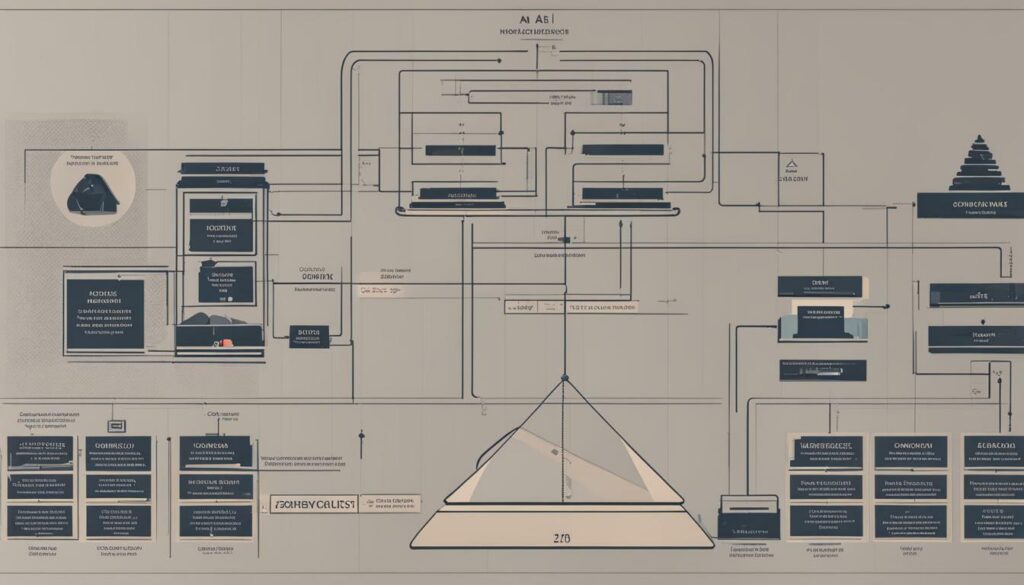Starting Guide: How to Build AI Software for Beginners

Artificial intelligence (AI) software is becoming increasingly prevalent in today’s digital landscape. Currently building AI software is a fabulous way to get into the AI space and make money. Businesses are leveraging AI to improve their operations, enhance customer experiences, and gain a competitive edge.
But building AI software can be daunting, especially for beginners. In this section, we will provide a step-by-step guide on how to build AI software, perfect for those new to the field. We will cover the basics of artificial intelligence programming and software development for AI.
But don’t worry, even if you don’t have a technical background, you can still learn how to build AI software. With the right resources and guidance, anyone can master the fundamentals of AI programming and software development.
Key Takeaways
- Building AI software requires a fundamental understanding of artificial intelligence programming and software development for AI.
- You’ll need to be familiar with programming languages like Python, C++, and Java, as well as tools and frameworks like TensorFlow and Keras.
- With the right resources and guidance, anyone can master the fundamentals of AI programming and software development.
- Starting small and building on your knowledge is key to successfully building AI software.
- Ethical considerations should always be taken into account when developing AI software.
Understanding AI Software Engineering
Building intelligent software is a complex process that requires a solid understanding of AI software engineering. This field involves the development of software that can perform intelligent tasks, such as recognizing speech, translating languages, or making predictions based on data.
To build effective AI applications, you need to consider factors such as algorithms, data models, and user interfaces. These components work together to create software that can learn, reason, and adapt to new situations.
AI software engineering involves a combination of disciplines, including computer science, mathematics, and cognitive psychology. It also requires specialized knowledge of programming languages such as Python and R, as well as machine learning frameworks such as TensorFlow and PyTorch.
Components of AI software engineering
AI software engineering involves several components, including:
- Data preparation and preprocessing
- Algorithm design and implementation
- Model training and evaluation
- System integration and deployment
Each of these components plays a critical role in building intelligent software. Data preparation and preprocessing involve cleaning and formatting data so that it can be used for training and testing algorithms.
Algorithm design and implementation involve creating models that can learn from data to make predictions or perform other tasks.
Model training and evaluation involve testing the performance of the algorithm against new data. System integration and deployment involve implementing the algorithm in a larger software system and making it available for use by end-users.
Building intelligent software
To build intelligent software, you need to consider several factors, including:
- The problem you are trying to solve
- The data you have available
- The algorithms you will use
- The user interface and user experience
By considering these factors, you can create software that meets the needs of your users and solves real-world problems. As you build your software, it’s important to test and evaluate its performance to ensure that it is reliable and effective.
Remember that AI software engineering is a constantly evolving field, and new technologies and techniques are emerging all the time. By staying up to date with the latest developments, you can create software that is innovative, effective, and ethical.

Congratulations, you now have a basic understanding of AI software engineering and are ready to start creating AI algorithms! Machine learning is an integral part of software development for AI and involves training software to recognize patterns and make predictions based on data.
To begin, you will need to select a machine learning technique that suits your specific requirements. Some popular techniques include:
- Supervised Learning: Training your software using labeled data
- Unsupervised Learning: Allowing your software to learn without labeled data
- Reinforcement Learning: Teaching your software to make decisions based on rewards or penalties
Once you’ve selected your technique, you can start creating AI algorithms. This involves defining your data inputs and outputs, selecting a model or algorithm, and training your software with relevant data.
It’s important to note that the quality of your data inputs can greatly impact the effectiveness of your AI algorithms. Make sure to select high-quality, relevant data and preprocess it to ensure it is suitable for training your software.
As you begin to test and evaluate your AI software, you may find that your algorithms need to be adjusted or refined. This is a normal part of the development process and can lead to higher performing software.
Remember to stay up-to-date with advancements in machine learning and explore how new techniques can enhance the capabilities of your software. With dedication and persistence, you can master machine learning for software development and create powerful AI solutions!

When it comes to designing AI applications, it’s important to have a clear understanding of your goals and requirements. This will help you determine which AI techniques and tools are appropriate for your project. One popular methodology for designing AI applications is the CRISP-DM (Cross-Industry Standard Process for Data Mining) model, which consists of six phases:
- Business Understanding
- Data Understanding
- Data Preparation
- Modeling
- Evaluation
- Deployment
Throughout these phases, you’ll collect and analyze data, build and test models, and deploy your solution. It’s important to note that the development of AI applications is an iterative process, and you may need to revisit certain phases as you gain more insight and refine your approach.
When developing AI software solutions, it’s important to keep in mind the end-users and their experience. Make sure your AI application is user-friendly, meaning it should provide clear instructions, intuitive controls, and easy-to-understand feedback. Additionally, stay up-to-date with advancements in AI technology, and be willing to adapt your approach as necessary.

By following these principles and methodologies for designing AI applications, you can create effective, efficient, and user-friendly AI software solutions that meet your specific needs and requirements.
Building Advanced AI Systems
Now that you’ve gained a fundamental understanding of AI software development, it’s time to take your skills to the next level by building advanced AI systems. By incorporating cutting-edge technologies and techniques, you can enhance the functionality and performance of your AI software to better serve your specific needs.
One key aspect of building advanced AI systems is understanding natural language processing (NLP). This technology enables computers to understand and interpret human language, which is critical for developing conversational agents and chatbots. Another important consideration is computer vision, which enables machines to interpret and analyze visual data, such as images and videos.
Developing advanced AI systems also requires a deep understanding of machine learning. By leveraging machine learning techniques, you can create more accurate and effective AI algorithms that can adapt and learn from new data. This can be particularly useful in applications such as predictive modeling and anomaly detection.
It’s important to keep in mind that building advanced AI systems requires extensive testing and optimization. A thorough understanding of the software development lifecycle is crucial to ensure that your AI systems are efficient, reliable, and trustworthy.

As you continue to develop your AI software solutions, don’t be afraid to push the boundaries and explore new technologies. By staying up to date with the latest developments in the field, you can ensure that your AI systems remain competitive and effective in a rapidly evolving landscape.
Exploring AI Software Development Tools
As you delve into AI software engineering and software development for AI, it’s important to have the right tools at your disposal. Fortunately, there is a wide range of tools and frameworks available to help streamline the development process and enhance the capabilities of your AI applications.
One popular option is TensorFlow, an open-source platform that enables you to build and train machine learning models. Another option is Keras, a high-level neural networks API that enables you to quickly prototype and experiment with different models.

Other tools to consider include PyTorch, which offers a seamless path from research to production, and Theano, which focuses on optimizing mathematical expressions involving multi-dimensional arrays.
When selecting your tools, it’s important to consider factors such as the level of support and community engagement, as well as the level of documentation and ease of use. By selecting the right tools for your needs, you can build and deploy powerful AI software solutions with greater ease and efficiency.
Testing and Evaluating AI Software
Testing and evaluating your AI software is crucial to ensure its quality and reliability. By doing so, you can identify and address any issues or bugs that may affect the performance of your AI software. There are different methodologies and techniques that you can use to test and evaluate your AI applications.
One popular approach is unit testing. This involves testing individual units or components of your AI software in isolation to ensure they are functioning correctly. You can use tools like JUnit or NUnit to automate your unit tests and streamline the testing process.
Another approach is integration testing, which involves testing how different components of your AI software work together. This can help identify any issues with communication or data transfer between different parts of your AI application.
Performance testing is another essential aspect of testing and evaluating your AI software. This involves testing the speed, scalability, and responsiveness of your AI application under different conditions and workloads. You can use tools like Apache JMeter or LoadRunner to test the performance of your AI software.
Finally, it’s essential to conduct user acceptance testing to ensure your AI software meets the requirements and expectations of users. This can involve gathering feedback from users on the functionality and usability of your AI application.
Overall, testing and evaluating your AI software is a crucial part of the development process. It helps ensure your AI application is reliable, efficient, and performs as expected. By using the right testing methodologies and techniques, you can identify and address any issues or bugs that may affect the performance of your AI software.

Congratulations! You have successfully built your AI software solution. Now it’s time to deploy it to make it available for use. The deployment process involves transferring your software from the development environment to the production environment. Here are the steps to follow:
- Choose a deployment method: Decide on the best way to deploy your AI software solution. You can deploy it to a cloud-based platform, a local server, or a dedicated hosting service. Your choice will depend on your specific needs, budget, and infrastructure.
- Prepare for deployment: Before you deploy your AI software solution, make sure it is fully tested and all issues are resolved. Prepare any necessary documentation or user guides that will help users navigate and utilize your software.
- Set up the deployment environment: Configure your production environment for the deployment of your AI software solution. Ensure that all necessary software, hardware, and network components are in place and functioning correctly.
- Deploy your software: Use your chosen deployment method and transfer your AI software solution to the production environment. Ensure that all necessary files, libraries, and dependencies are included.
- Test your deployment: After deployment, thoroughly test your AI software solution in the production environment to ensure that it is functioning as expected. Address any issues that arise during testing.
Deploying your AI software solution is an important step in making it available for use. Use these steps to ensure that your deployment process goes smoothly and your software is ready for action.

As you delve into the world of AI software engineering and developing AI software solutions, it is important to consider the ethical implications of your work. The responsible use of AI has become a highly debated topic, with concerns around privacy, fairness, and accountability.
One key consideration is the potential for AI to perpetuate biases and discrimination. This can occur when AI algorithms are trained on biased data or when they are used to automate decisions that directly impact people’s lives. It is crucial to carefully scrutinize your data sets and ensure that they are diverse and representative of the population.
Another ethical consideration is the transparency and explainability of AI systems. As AI becomes increasingly powerful and complex, it can become difficult to understand how decisions are being made. It is essential to design AI systems that can be easily explained to stakeholders, whether they are end-users or regulatory bodies.
Furthermore, it is important to consider the potential impact of AI on employment and the workforce. As AI systems become more widespread, they may replace certain jobs, leading to job displacement and economic disruption. It is crucial to consider the social and economic implications of AI and ensure that the benefits of this technology are shared equitably.

Maintaining and Updating AI Software
Congratulations, you’ve successfully built your AI software! But, your journey doesn’t end there. To ensure the longevity and continued effectiveness of your software, it is crucial to prioritize maintenance and updates.
Regular updates can improve the performance of your software and provide new functionalities. It is important to keep up with advancements in the field and update your software accordingly.
Maintenance is also critical to keep your software running smoothly. It involves checking for and fixing any bugs or errors that may arise, as well as monitoring the performance of your software.
It can be helpful to set up automated monitoring and update systems to streamline the maintenance process. This can save you time and resources in the long run.
Remember, maintaining and updating your AI software is a continuous process. It is important to stay vigilant and proactive to ensure the continued success of your project.

Congratulations on completing this step-by-step guide on how to build AI software for beginners! By following these fundamental principles of artificial intelligence programming and software development for AI, you are well on your way to building intelligent software that can enhance business operations, solve complex problems, and improve people’s lives.
As you continue to explore the world of AI software engineering, remember to stay up to date with advancements and best practices in the field. Always prioritize ethical considerations and responsible use of AI, ensuring that your applications are designed to protect user privacy, promote fairness and transparency, and foster accountability.
In conclusion, as you embark on your journey of developing AI software solutions, it is important to prioritize ethical considerations. By designing and developing AI systems that are fair, transparent, and accountable, we can ensure that AI is used for the betterment of society.
Don’t forget about the importance of maintaining and updating your AI software over time. By regularly testing, evaluating, and improving your applications, you can ensure their longevity and continued effectiveness.
Overall, building AI software requires patience, perseverance, and a willingness to learn and adapt. With these principles in mind, you are well-equipped to embark on your AI journey and start building intelligent software today!
FAQ How to Build AI Software
Q: How do I get started with building AI software?
A: To get started with building AI software, you need to have a basic understanding of artificial intelligence programming and software development. This involves learning programming languages such as Python and familiarizing yourself with machine learning techniques and algorithms. There are many online resources and courses available for beginners to learn the foundations of AI software development.
Q: What are the key components of AI software engineering?
A: AI software engineering involves several key components, including data collection and preprocessing, algorithm development, model training, and deployment. It is important to have a solid understanding of these components and how they interact to build successful AI applications.
Q: How can machine learning be leveraged in software development?
A: Machine learning can be leveraged in software development by creating AI algorithms that learn from data and improve their performance over time. This can lead to more intelligent and adaptive software solutions that can make predictions, classify data, or automate tasks based on patterns and trends.
Q: What is the process of designing AI applications?
A: The process of designing AI applications involves identifying the problem or task you want to solve, collecting and preparing relevant data, selecting and training appropriate machine learning models, and evaluating and refining the performance of your AI application. It is essential to consider the specific requirements and constraints of the problem you are solving to design effective AI solutions.
Q: How can I enhance the functionality of my AI software?
A: You can enhance the functionality of your AI software by incorporating cutting-edge technologies and techniques. This may include utilizing deep learning models, implementing natural language processing capabilities, or integrating computer vision algorithms. Staying up to date with the latest advancements in AI can help you build more advanced and powerful software solutions.
Q: What tools and frameworks are available for AI software development?
A: There are numerous tools and frameworks available for AI software development, such as TensorFlow, PyTorch, scikit-learn, and Keras. These frameworks provide pre-built functions and libraries for tasks like data manipulation, model training, and evaluation, making it easier to develop AI applications. It is important to research and choose the tools that best suit your specific needs and requirements.
Q: How can I ensure the quality and reliability of my AI software?
A: Testing and evaluating AI software is crucial to ensure its quality and reliability. This involves conducting comprehensive testing, including unit testing, integration testing, and performance testing. Additionally, it is important to monitor and evaluate the performance of your AI applications in real-world scenarios and continually update and improve them to maintain their effectiveness.
Q: What steps are involved in deploying AI software?
A: Deploying AI software involves packaging and distributing your application to make it accessible for use. This may involve deploying your models on cloud platforms, creating APIs for integration with other systems, or developing user-friendly interfaces. It is important to consider scalability, security, and performance when deploying AI applications.
Q: What ethical considerations should I keep in mind when developing AI software?
A: Ethical considerations are crucial in AI software development. It is important to ensure that your AI applications are fair, transparent, and unbiased. Privacy and data security should also be prioritized to protect user information. Additionally, accountability and responsible use of AI should be considered to mitigate potential negative impacts on individuals and society.
Q: How can I maintain and update my AI software?
A: To maintain and update your AI software, it is important to regularly monitor its performance and address any issues that arise. This may involve fixing bugs, updating models and algorithms, and adapting your software to evolving user needs. Staying up to date with advancements in AI technology and participating in the AI community can also help you continually improve and enhance your software.
